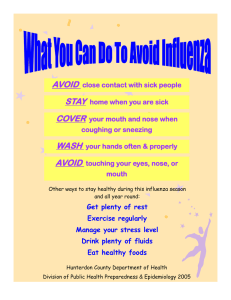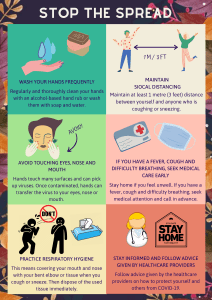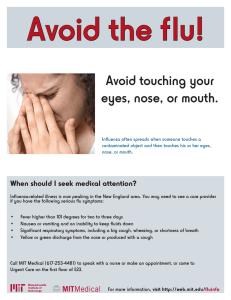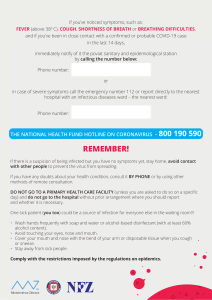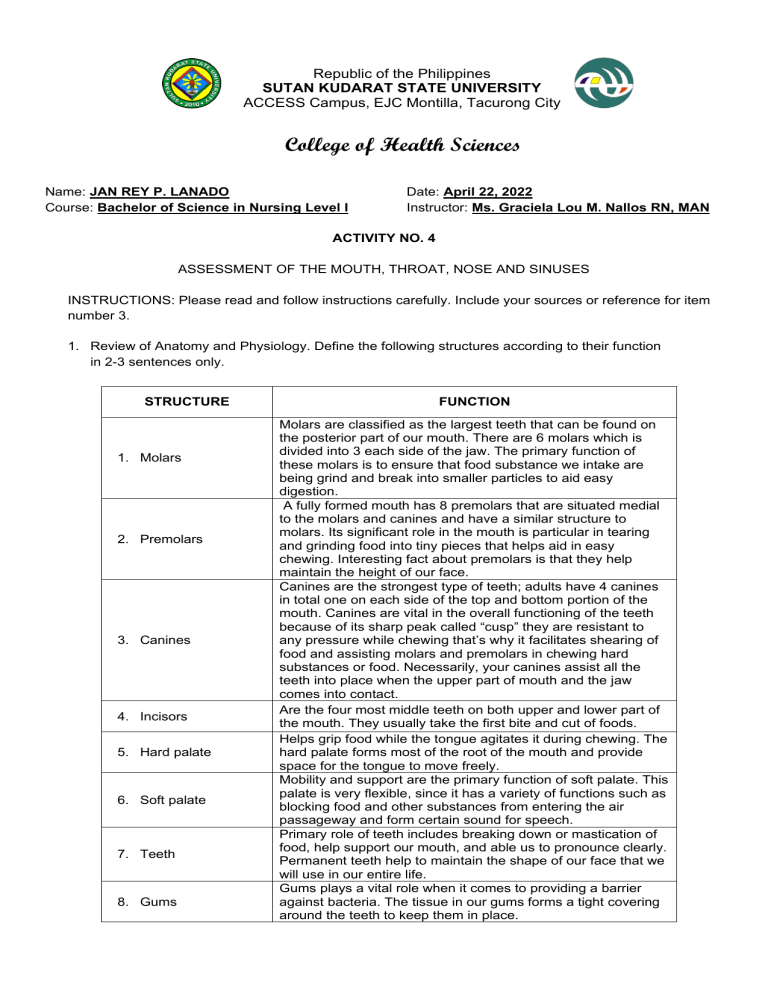
Republic of the Philippines SUTAN KUDARAT STATE UNIVERSITY ACCESS Campus, EJC Montilla, Tacurong City College of Health Sciences Name: JAN REY P. LANADO Course: Bachelor of Science in Nursing Level I Date: April 22, 2022 Instructor: Ms. Graciela Lou M. Nallos RN, MAN ACTIVITY NO. 4 ASSESSMENT OF THE MOUTH, THROAT, NOSE AND SINUSES INSTRUCTIONS: Please read and follow instructions carefully. Include your sources or reference for item number 3. 1. Review of Anatomy and Physiology. Define the following structures according to their function in 2-3 sentences only. STRUCTURE 1. Molars 2. Premolars 3. Canines 4. Incisors 5. Hard palate 6. Soft palate 7. Teeth 8. Gums FUNCTION Molars are classified as the largest teeth that can be found on the posterior part of our mouth. There are 6 molars which is divided into 3 each side of the jaw. The primary function of these molars is to ensure that food substance we intake are being grind and break into smaller particles to aid easy digestion. A fully formed mouth has 8 premolars that are situated medial to the molars and canines and have a similar structure to molars. Its significant role in the mouth is particular in tearing and grinding food into tiny pieces that helps aid in easy chewing. Interesting fact about premolars is that they help maintain the height of our face. Canines are the strongest type of teeth; adults have 4 canines in total one on each side of the top and bottom portion of the mouth. Canines are vital in the overall functioning of the teeth because of its sharp peak called “cusp” they are resistant to any pressure while chewing that’s why it facilitates shearing of food and assisting molars and premolars in chewing hard substances or food. Necessarily, your canines assist all the teeth into place when the upper part of mouth and the jaw comes into contact. Are the four most middle teeth on both upper and lower part of the mouth. They usually take the first bite and cut of foods. Helps grip food while the tongue agitates it during chewing. The hard palate forms most of the root of the mouth and provide space for the tongue to move freely. Mobility and support are the primary function of soft palate. This palate is very flexible, since it has a variety of functions such as blocking food and other substances from entering the air passageway and form certain sound for speech. Primary role of teeth includes breaking down or mastication of food, help support our mouth, and able us to pronounce clearly. Permanent teeth help to maintain the shape of our face that we will use in our entire life. Gums plays a vital role when it comes to providing a barrier against bacteria. The tissue in our gums forms a tight covering around the teeth to keep them in place. 9. Frenulum 10. Buccal mucosa 11. Tongue 12. Uvula 13. Wharton’s duct 14. Lips 15. Oral cavity 16. External nostrils 17. Septum 18. Frontal Sinuses 19. Maxillary Sinuses 20. Ethmoid Sinuses 21. Sphenoid Sinuses 22. Pharynx 23. Larynx 24. Epiglottis 25. Tonsils It helps to anchor the tongue to its place by connecting it to the floor of the mouth. It supports and aids in limiting its movement in different direction. Buccal or oral mucosa serve its function as a protective barrier to the deeper tissue such as fats, muscle, nerve and blood supplies. It is important to avoid trauma during chewing because of pressure. As a digestive organ, tongue facilitate the movement of food during mastication and swallowing. Some other significant role includes sense of taste and for speech. Uvula can be also considered as an organ for speech, it keeps the throat moist and lubricated via secreting large amount of saliva. Also helps food and fluids from ending up in the space behind your nose when you swallow. Carries the saliva into the mouth and helps it move through your mouth. It is a key component that helps us eat, drink, and prevent cavities. Lips serves to close and shut the mouth to hold foods and fluids inside. Lips also provide competence to the oral cavity during mastication and rest. Oral cavity or the mouth is the first part of the digestive tract. It serves its function by receiving the food we intake by ingestion, break them into smaller particles by mastication, and mixed them with saliva for easy swallowing. Anterior nares or nostrils are the two external opening of the nose. It allows air to enter the nose and pass into the nasal cavity. The main purpose of the septum is to allow the air we inhale or inspire directly to the lungs. Without this the air we breathe in might get loss and cannot directly go into the lungs. Forms the lower part of the forehead and reaches over the eye sockets and eyebrows. They are lined with cells that make mucus to keep the nose from drying out. These sinuses are small air-filled holes found in the bones of the face. They reduce skull weight, produce mucus, and affect the tone of a person’s voice. Like other sinus cavities, these sinuses provide lubrication to the nasal cavity. It also reduces the overall weight of the skull and make the voice of a person more resonant as they grow during puberty. It filters and clean the air breathe through the nose and lighten the bones of the skull. It is also an attachment site for many of the muscle of mastication. Also called as the throat, work as passageway that serves both respiratory and digestive system. It receives food and fluid down from the nose and mouth. Its significant role includes letting air pass from the throat to the trachea down to the lungs. Larynx or the voice box contains vocal cords which is essential to human speech. It closes the entrance of the larynx and trachea during swallowing. And allows the air to pass into the windpipe. It might be sometimes neglected but it plays a vital role in preventing foreign substances from entering the lungs that may cause respiratory illnesses. On top of that they also filter viruses and bacteria and produces antibodies to fight back for possible foreign materials. 2. Abnormal Findings. List 5 abnormal findings for mouth and throat and 5 abnormal findings for the nose and sinuses. Briefly define the findings identified. Abnormal Findings for Mouth and Throat FINDINGS DESCRIPTION 1. COLD SORES 2. 3. 4. 5. Caused by a virus that results to painful sores on the lips and around the mouth. ORAL CANCER Oral cancer is common to people who smokes and/ or drink heavily. It leads to the growth of ulcer that appears on the tongue and grow continuously. HAIRY TONGUE Papillae can overgrow to the surface of the tongue, giving it a white or black appearance. ATROPHIC Bald tongue means loses its bumpy texture that leads it to GLOSSITIS become smooth. Sometimes this maybe due to anemia or vitamin B deficiency. MACROGLOSSIA It could be congenital, inflammatory, traumatic, or cancerous causes. Thyroid diseases and congenital abnormalities are among some of the enlarged tongue. Abnormal Findings for Nose and Sinuses FINDINGS 1. ALLERGIC RHINITIS 2. INVERTING PAPILLOMA 3. FUNGAL SINUSITIS 4. CHRONIC SINUTIS WITH POLYPS 5. DEVIATED SEPTUM DESCRIPTION Membranes that line the nose are inflamed. Tumors that are benign forms inside the nose. Caused by infecting fungi around the external environment and cause an allergic reaction that might result to thick fungal debris and blockage of the infected sinuses. Inflammation of the sinuses that occur and last for 12 weeks and associated with nasal polyps. Occurs when the thin wall or the nasal septum between the nasal passages is displaced to one side. References: Types of teeth and their function https://www.t32dental.com/articles/4-types-of-teeth/ Britannica, The Editors of Encyclopaedia. "mouth". Encyclopedia Britannica, https://www.britannica.com/science/mouth-anatomy. Accessed 22 April 2022. Mouth anatomy https://emedicine.medscape.com/article/1899122-overview Mouth disorders https://medlineplus.gov/mouthdisorders.html Mouth problems https://www.dentalhealth.org/pages/category/conditions-and-diseases?take=16&Take=15 Nose and sinus disorders https://www.uofmhealth.org/conditions-treatments/ear-nose-throat/sinus 13 May. 2020,
